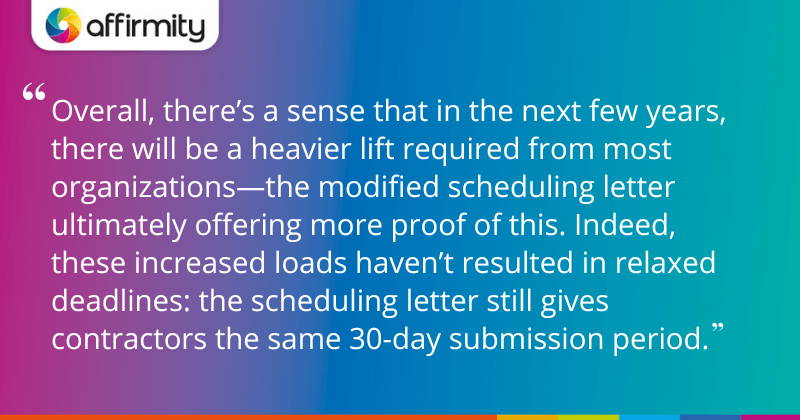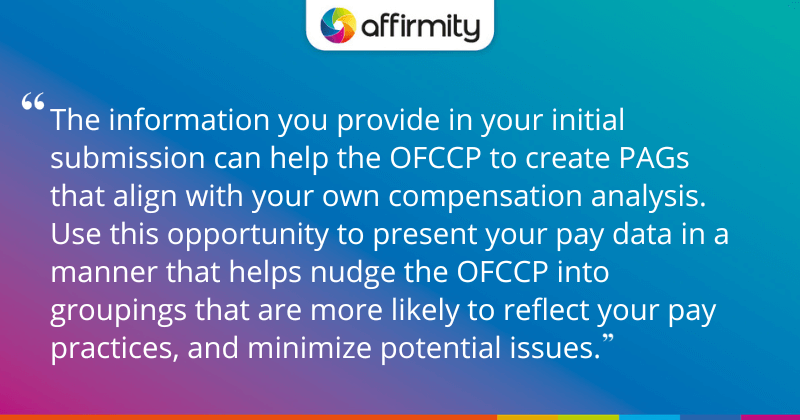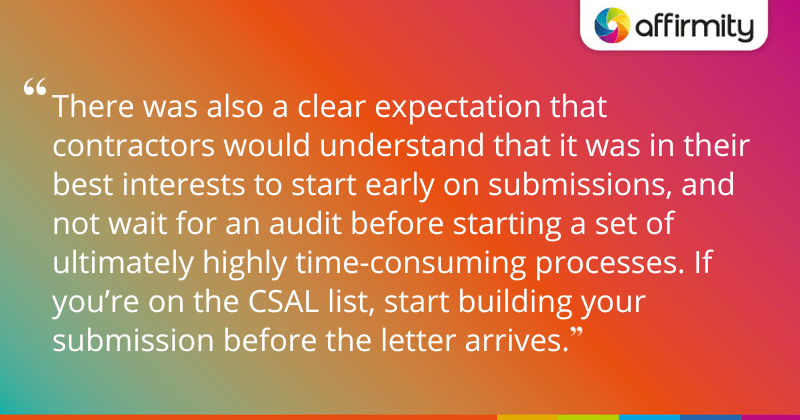This year’s National Industry Liaison Group (NILG) conference gave us a full week of affirmative action and equal employment opportunity compliance insights from practitioners and lawmakers alike. As ever, the topics discussed promise to resonate in the months and years ahead, prompting best practices and federal focal points that will shape your organization. In this article, Zoe Ann Whitley and Brad Wiltshire have pulled together 10 of the biggest insights for a deep analysis—use the handy index below to jump to the topics most relevant to you.
- The OFCCP Has Shared Its Current Objectives
- The EEOC Is Also Focused on Enforcement
- Audit Preparation Remains Paramount
- Contractors Must Be Cautious About Compensation Analysis Requests
- Employers Should View the Internet Applicant Rule As an Opportunity
- Here’s How the OFCCP Approaches Compensation Analysis
- The OFCCP Expects Your Compensation Analysis to Be Robust and Year-Round
- Yes, State-Level Compensation Reporting Is Fragmented
- It’s Time to Reevaluate Your Approach to Hiring Veterans and People With Disabilities
- Supreme Court Rulings on Affirmative Action in College Admissions
1) The OFCCP Has Shared Its Current Objectives
As usual for NILG, representatives from the major federal agencies received top billing, providing a peek behind the curtain at their operations and goals for the year ahead. Michele Hodge, Acting Director of the OFCCP, primarily talked about strengthening enforcement and ensuring greater compliance.
For example, we learned that proposed plans to revise the scheduling letter will see the OFCCP seeking more data from contractors—something we saw them follow through on in short order, when a revised combined scheduling letter and itemized listing was made available at the end of August 2023.
As evidenced by the revised letter, we can expect the OFCCP to continue making greater compliance documentation demands. We get the sense that the OFCCP is getting a lot of pushback from federal contractors with regard to this data. Though organizations want to ensure this data is protected, and while there are valid approaches to do so (as we’ll go into later), Hodge was keen to reemphasize that the agency has a right to ask for this information.
The Acting Director also addressed the Pre-enforcement Notice and Conciliation Procedures (PDN) which has gone into effect as of August 1, rescinding the evidentiary standards and definitions codified in 2020. Another key focus is construction—a consequence of the current administration’s focus on infrastructure projects—ensuring that equal opportunities are promoted in the construction industry and barriers to representation are removed.
2) The EEOC Is Also Focused on Enforcement
EEOC Chair Charlotte Burrows was similarly focused on enforcement, talking specifically on harassment issues and retaliation, and again stating her agency is working on ensuring that construction contracts weren’t being used to promote discrimination.
Burrows also highlighted the EEOC’s Artificial Intelligence and Algorithmic Fairness Initiative which endeavors to “examine more closely how existing and developing technologies fundamentally change the ways employment decisions are made”, and will “provide guidance on algorithmic fairness”. She also talked through the EEOC’s proposed Pregnant Workers Fairness Act, which “requires covered employers to provide reasonable accommodations to a worker’s known limitations related to pregnancy, childbirth, or related medical conditions, unless the accommodation will cause the employer an undue hardship.”
Burrows also discussed compensation data—which between Hodge’s focus on the topic, and several other talks on the subject, was really a theme that dominated much of the conference. Observing that, while states have been collecting compensation data, organizations were faced with a rather patchwork approach. She hinted that while there wasn’t currently a federal-level or country-wide approach, the EEOC itself was working on something and it would be up for public comment at some future date. The discussion hinted that there will likely be modifications when compared to EEOC Component Two, the agency’s previous attempt at studying contractors’ compensation data.

3) Audit Preparation Remains Paramount
Audits were probably brought up in some form or fashion at every workshop during the conference. Overall, there’s a sense that in the next few years, there will be a heavier lift required from most organizations—the modified scheduling letter ultimately offering more proof of this. Indeed, these increased loads haven’t resulted in relaxed deadlines: the scheduling letter still gives contractors the same 30-day submission period.
The upshot of this is that organizations need to be ready to act as quickly as possible if they’re named on the CSAL (as 1,000 contractors and subcontractors were on Friday, September 8, 2023). Anecdotally, things can move fast: one client on last year’s CSAL received their scheduling letter barely a week later. So many of the workshops at NILG recommended not only thorough self-auditing of every aspect of your plans and documentation, but of your systems too. You need to be confident that everything that comes out of your ATS or your HRIS is accurate and that it can be reconciled.
On top of this, it’s imperative that you get to know your data like never before. You want to know where red flags are way before the audit letter comes so you have a chance to investigate them.
READ MORE ON AUDIT PREPARATION | ‘4 Signs That Your Applicant Data Won’t Pass an OFCCP Audit’
4) Contractors Must Be Cautious About Compensation Analysis Requests
With the OFCCP now requiring contractors to submit documentation regarding their compensation analyses, organizations have been looking for guidance on exactly how much information they are obliged to hand over. For example, though a regression analysis may be necessary for the organization to have a full understanding of the impacts of its current pay practices, such analyses should still be done under attorney-client privilege. At the same time, in the event of an audit, an organization will still be required to provide some form of compensation analysis that sufficiently demonstrates that pay was reviewed for racial/ethnic and gender disparities.
Workshops at NILG stressed the importance of establishing whether the OFCCP has the legal authority to ask for the data it requests. Furthermore, it’s important to work with the OFCCP to ensure that you fully understand what is being requested, to ensure that the timeline for the request is reasonable, and to provide only what it requests and nothing more.
5) Employers Should View the Internet Applicant Rule As an Opportunity
The Internet Applicant rule has been with us since 2006, defining for OFCCP compliance purposes who counts as an applicant versus a job seeker. To be an applicant, an individual must have:
- Applied
- Been considered for a particular role
- Met the basic qualifications for the role
- Not withdrawn from consideration prior to receiving an offer of employment
The OFCCP has reached a large number of failure-to-hire settlements recently, and the consensus is that organizations’ poor record keeping is the main cause.
Armed with the OFCCP’s clear definition of who is and who isn’t an applicant, it’s critical that you work to ensure that everyone is properly dispositioned and that everyone who shouldn’t be in the hiring pool doesn’t make it into your submission data. This means you will need to make sure that recruiters are trained from day one on correct dispositioning and that they understand how to do it properly, and why it’s important that they do it.
You also need to tighten up your job listings so that you list accurate basic and preferred qualifications, and ensure they remain consistent. If it’s absolutely essential that you change those specifications, you should create a separate requisition and retire the old one.
This does mean that unsolicited applications should be considered a risk factor, and the prevailing wisdom is that organizations shouldn’t accept them at all. Give everyone the same messaging: make it clear that you don’t accept unsolicited applications, and direct them to the available positions on your job platform. Referrals and promising candidates encountered at places like job fairs should also be routed via the same job listings as everyone else. If an applicant is interested in multiple jobs, make sure the system requires them to apply to each job individually.
While this rigid approach may not offer the most convenience for your candidates, it’s nonetheless an important measure to take that will protect you in the long run. However, be careful to not leave people behind: prompt potential applicants to go to a local library for web access, and consider providing a kiosk for applications at the events you attend, or in the lobby of your premises.

6) Here’s How the OFCCP Approaches Compensation Analysis
In addition to this year’s general focus on compensation analysis, NILG attendees were given a small but nonetheless useful degree of insight into the thought processes and methodologies of the OFCCP’s statisticians.
The OFCCP sees pay equity as about “pay outcomes” rather than “pay differences”. Consequently, its initial pay analyses are performed according to similarly situated groups or job groups. During the OFCCP’s auditing process, it will take the information you provide (as described in Item 19 of the itemized listing) and it will create its own “Pay Analysis Groups” (PAGs, in its internal terminology).
The information you provide in your initial submission can help the OFCCP to create PAGs that align with your own compensation analysis. However, auditors may choose alternative groupings if they feel there is justification to do so. Use this opportunity to present your pay data in a manner that helps nudge the OFCCP into groupings that are more likely to reflect your pay practices, and minimize potential issues.
The OFCCP doesn’t prescribe any specific assessment tools to be used for in-depth compensation analyses, but in discussion at NILG it did indicate some basic expectations. For example, at minimum, it expects contractors to conduct an average pay ratio and cohort analysis. Other aspects of its analysis that may be helpful to understand include:
- The OFCCP states that it conducts a barrier analysis during its desk audit phase. It referred to “zooming in and out” and applying many different lenses on your compensation data, such as looking at your data at the job group level, or job title or functional areas.
- When an organization is under audit, the OFCCP will typically start its review of compensation by using the contractor’s own analysis. Statisticians at NILG described a “triage” process looking at flagged areas. The agency references the item 19 data you provide, and then it builds more sophisticated analyses that considers tenure and structural variables.
- The OFCCP also indicated that it looks beyond salaries. It’s particularly interested in “career stalls”—evidence of individuals encountering barriers to promotion opportunities, which could ultimately impact their pay.
MORE ON PAY EQUITY | “A 5-Point Plan for Designing a Culture That Embraces Pay Equity”
7) The OFCCP Expects Your Compensation Analysis to Be Robust and Year-Round
The OFCCP’s expectations for how contractors approach compliance shouldn’t surprise anyone, though they bear repeating. It expects that you will:
- Conduct robust compensation reviews
- Be proactive and deliberate, ensuring that all of the relevant compensation is analyzed
- Keep all of your pay policies and related documentation current and easily accessible
- Maintain documentation and data on all compensation factors—ensuring that those factors are defensible
- Consider multiple analyses when reviewing compensation, and ensure those analyses are conducted by gender and race breakout (not just at a “total minority” level)
- Conduct ongoing analysis (and not treat it as a one-and-done)
- Create a narrative summary of all compensation studies explaining the how and why of what was looked at, and the results.
There was also a clear expectation that contractors would understand that it was in their best interests to start early on submissions, and not wait for an audit before starting a set of ultimately highly time-consuming processes. If you’re on the CSAL list, start building your submission before the letter arrives.
8) Yes, State-Level Compensation Reporting Is Fragmented
In addition to the federal-level discussion, the EEOC Chair and other NILG panelists mentioned state-level compensation reporting. Organizations must be careful to pay attention to the different requirements in every state they do business in, and should be proactive in reviewing all data they may be required to submit.
While new requirements are popping up every year, it’s important to remember that the only states/jurisdictions that at this time request some form of compensation data are California, Illinois, Minnesota, and the District of Columbia, with California and Illinois having the most robust requirements. EEOC Chair Burrows referred to this as a “patchwork” approach, and hinted that the return of a federal compensation data requirement was in development, although she did not provide a timeline.

9) It’s Time to Reevaluate Your Approach to Hiring Veterans and People With Disabilities
Various workshops provided helpful pointers about disabled and veteran outreach and inclusivity. It was acknowledged that many organizations tend to do only the bare minimum of what’s required for these groups—for example, just posting positions to the state job board alone. Instead, organizations should be assessing their programs internally, identifying areas for improvement, training recruiters on where to find qualified veterans and individuals with disabilities, and encouraging them to apply for your organization.
With regard to veterans, one important theme was that organizations need to work on understanding the skillsets of military personnel and how those can be applied in their workplace. Partly, this is about understanding that there are a wide range of roles within the military—roles that are similar or equivalent to those in the civilian sector. Indeed, one speaker observed that the vast majority of people in the military aren’t in combat roles. That said, the terminology isn’t always the same, so it’s important to know the names of these equivalent roles and use those terms in your search for suitable candidates.
A similar approach is needed for individuals with disabilities. An organization must strive to understand how they’re looking for jobs, and what they’re looking for in those jobs. This could be a case of using disability-inclusive messaging, statements from your CEOs, information about your ERGs, or videos and other content featuring contributions from current staff that reinforce your suitability as an employer. People like to be in a place where they feel like they have peers, and it’s important to highlight how inclusive your workplace is.
LOOK INTO OUTREACH | ‘5 Key Affirmative Action Outreach Resources (And What You Should Record About Your Efforts)’
10) Supreme Court Rulings on Affirmative Action in College Admissions Do Not Directly Impact Employers, But Are Not Completely Irrelevant
Agency leads and several attorneys who spoke at NILG emphasized that the Supreme Court’s recent decisions in the UNC and Harvard College admissions cases do not apply to affirmative action in the employment context. Though the two spheres use similar terminology, affirmative action in the college admissions context considered race as a factor and potentially a preference for selection, something that is specifically prohibited under Title VII in the corporate world.
However, while the cases do not have a direct impact on employers, some indirect consequences are likely. Over time it is possible that the change in admissions policies the ruling forces could reshape future availabilities, although the full impact may not be seen for several years. More immediately, it’s likely that some groups will misinterpret the ruling and will attempt to take action against employers for affirmative action and perhaps diversity efforts. Shortly after the ruling, attorneys general from 13 states sent a letter cautioning Fortune 100 CEOs that the ruling could apply to private entities, should it be found that they use race as a factor in making employment decisions. Regardless of the validity of this claim, there is possibly a perception that these programs are intentionally or unintentionally discriminating against certain groups in order to meet diversity goals.
In such a climate, the main takeaway is that organizations need to be careful what they’re doing. If you’re reserving placements for certain groups to improve representation, you’re taking an action that has always been prohibited. In another sphere, if you’re using race or gender as a factor in who can join certain Employee Resource Groups (ERGs), that may cause you issues—membership should be open to all, regardless of the focus of the group.
Discover how Affirmity can help you prepare for affirmative action planning and audit activity: check out our affirmative action plan services or contact us for more information.
About Our Authors
 Zoe Ann Whitley, PHR, is a Director of Consulting Services at Affirmity. In this role, she leads and manages a team of Affirmity consultants who provide audit support and consulting on affirmative action, equal employment opportunity, and diversity. She has over 20 years of compliance experience, including serving as a compliance manager for a large federal contractor. Ms. Whitley’s experience spans US and Canadian compliance, affirmative action, employee relations, recruitment, diversity, and training.
Zoe Ann Whitley, PHR, is a Director of Consulting Services at Affirmity. In this role, she leads and manages a team of Affirmity consultants who provide audit support and consulting on affirmative action, equal employment opportunity, and diversity. She has over 20 years of compliance experience, including serving as a compliance manager for a large federal contractor. Ms. Whitley’s experience spans US and Canadian compliance, affirmative action, employee relations, recruitment, diversity, and training.
 Brad Wiltshire is a Manager of Consulting Services at Affirmity. He has 15 years of experience developing Affirmative Action Plans as well as EEO-1, and VETS reports for clients across many industries. A former attorney, Mr. Wiltshire’s legal background has helped him provide ongoing guidance and support for OFCCP audits and other compliance needs. Connect with him on LinkedIn.
Brad Wiltshire is a Manager of Consulting Services at Affirmity. He has 15 years of experience developing Affirmative Action Plans as well as EEO-1, and VETS reports for clients across many industries. A former attorney, Mr. Wiltshire’s legal background has helped him provide ongoing guidance and support for OFCCP audits and other compliance needs. Connect with him on LinkedIn.
